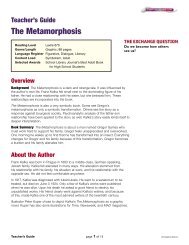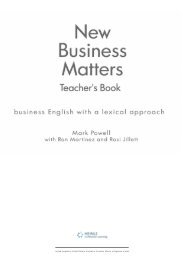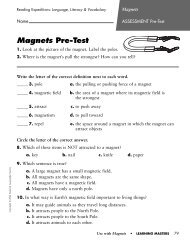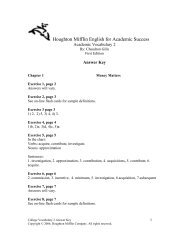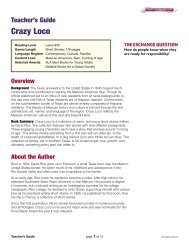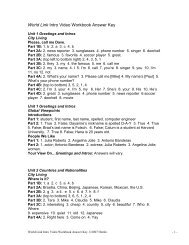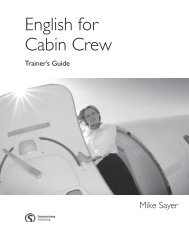Top 20, Great Grammar for Great Writing, First Edition Teaching Notes
Top 20, Great Grammar for Great Writing, First Edition Teaching Notes
Top 20, Great Grammar for Great Writing, First Edition Teaching Notes
Create successful ePaper yourself
Turn your PDF publications into a flip-book with our unique Google optimized e-Paper software.
<strong>Top</strong> <strong>20</strong>, <strong>Great</strong> <strong>Grammar</strong> <strong>for</strong> <strong>Great</strong> <strong>Writing</strong>, <strong>First</strong> <strong>Edition</strong><strong>Teaching</strong> <strong>Notes</strong>http://esl.college.hmco.com/instructorsCopyright Houghton Mifflin CompanyChapter 16Adjective ClausesOverviewAdjective clauses and reduced adjective clauses are covered in Chapter 16. The chapteralso discusses restrictive and non-restrictive clauses and reductions of clauses.<strong>Teaching</strong> <strong>Notes</strong>Adjective Clauses and Relative Pronouns (16.1)A review of the relative pronouns used in adjective clauses starts off this chapter.Students should be reminded that the relative pronoun who is preferred when referring topeople and the relative pronoun that is preferred <strong>for</strong> restrictive clauses with things.Exercise 1 can be used as an introduction to adjective clauses. Exercise 2 offers editingpractice in the correct usage of relative pronouns.Non-restrictive and Restrictive Adjective Clauses (16.2)Very often students want to know if a clause MUST be restrictive or non-restrictive.Usually, both <strong>for</strong>ms are correct in <strong>for</strong>m. The correctness of a restrictive or non-restrictiveclause depends mainly on the meaning that one is trying to convey. In Exercise 3,students can practice combining independent clauses into complex sentences withadjective clauses. Explain to the students that in all of these items, the adjective clause isEXTRA INFORMATION; there<strong>for</strong>e, the clauses are non-restrictive. Exercise 4 is a bitmore complicated because it asks the students to decide whether a clause is punctuatedcorrectly.Subject and Object Relative Pronouns (16.3)This section offers explanations <strong>for</strong> the use of subject pronouns (16.3.1) and objectpronouns (16.3.2). This section also explains the usage of whom as a relative pronoun.Students should know that in academic writing, it is always considered better <strong>for</strong>m to usewhom than who. Exercise 5, as a fill in the blank exercise, often contains more than onecorrect answer.Omitting the Object Relative Pronoun (16.3.3)A very important part of adjective clauses—reductions—is included in this section.Exercise 6 asks the students not only to find the relative pronouns, but also to deleterelative pronouns that are not necessary in the sentence. Have the students analyze thein<strong>for</strong>mation that comes directly after the relative pronoun be<strong>for</strong>e deciding to keep ordelete the item.Relative Pronouns as Objects of Prepositions in Adjective Clauses (16.4)1



